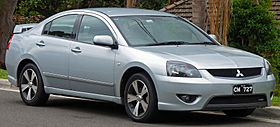| Mitsubishi 380 | |
|---|---|
 | |
| Overview | |
| Manufacturer | Mitsubishi Motors |
| Model code | DB |
| Production | October 2005 – March 2008 |
| Assembly | Australia: Adelaide, South Australia (Clovelly Park) |
| Designer | Olivier Boulay |
| Body and chassis | |
| Class | Mid-size car |
| Body style | 4-door sedan |
| Layout | Front-engine, front-wheel-drive |
| Platform | Mitsubishi PS platform |
| Related | Mitsubishi Galant |
| Powertrain | |
| Engine | 3.8 L 6G75 V6 |
| Transmission | 5-speed manual 5-speed automatic |
| Dimensions | |
| Wheelbase | 2,750 mm (108 in) |
| Length | 4,837–4,855 mm (190.4–191.1 in) |
| Width | 1,840 mm (72 in) |
| Height | 1,480 mm (58 in) |
| Curb weight | 1,625–1,670 kg (3,583–3,682 lb) |
| Chronology | |
| Predecessor | Mitsubishi Magna/Verada |
The Mitsubishi 380 is a mid-size car that was produced between 2005 and 2008 by Mitsubishi Motors Australia. Available only as a sedan, it marked the end of Australian production by the Japanese manufacturer.
The 380, given the model designation DB, was the successor to the Mitsubishi Magna / Verada line of vehicles first introduced in 1985 (1991 for the Verada). The company spent over A$600 million developing and producing the car, being heavily based upon the ninth generation Mitsubishi Galant designed in the United States.[1] The 380 continued Mitsubishi Australia's established habit of producing front-wheel drive sedans for the Australian market, and along with the Toyota Aurion, competed against traditionally well-established local rear-wheel drive Ford Falcon and GM Holden Commodore vehicles.
Even before the car's launch in October 2005, the 380 was stigmatised as the "make or break" model for Mitsubishi Australia.[2] After a slow sales start, the line-up was updated with the Series II in April 2006, with the entry-level model attracting a price discount of nearly 20 percent.[3] To generate further interest in the car, a Series III revision came on 29 July 2007 with mainly cosmetic changes.[4] These updates failed to lift sales, and with production still unprofitable, Mitsubishi ceased manufacturing of the 380 in March 2008 after just short of three years in production. A total of 32,044 were produced over the three year production, of which 30,195 were sold in Australia.
- ^ Tan, Paul (4 February 2006). "Mitsubishi 380 3.8L V6". Paultan.org. Retrieved 20 January 2009.
- ^ Torr, Feann (30 November 2005). "Road Test: Mitsubishi 380 GT". WebWombat. Retrieved 11 January 2008.
- ^ Williamson, Russell (28 April 2006). "Mitsubishi's Revolution (April 2006)". carsales.com.au. Archived from the original on 20 September 2011. Retrieved 11 January 2008.
- ^ "2007 Mitsubishi 380 Series III Sedan". Car Advice. 17 July 2007. Retrieved 11 January 2008.